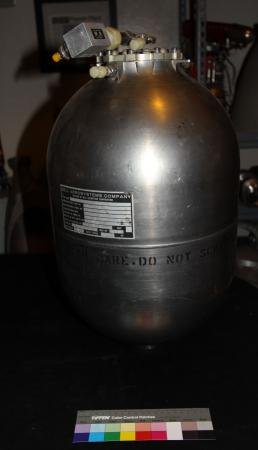Artifact: Oxidizer Tank, Reaction Control System (RCS), Apollo Command Module, Block II
Shell: Titanium, Internal Expulsion Bladder: Teflon (TEF/TEP), Defuser Assembly - Aluminum/Stainless Steel
Apollo Command Module (Block II) Propellant tank which supplied Nitrogen Tetroxide (N204) oxidizer to the spacecraft's twelve Rocketdyne SE-8 Reaction Control Sytem (RCS) engines. A similar tank was used to store the fuel (Monomeythydrazine - MMH) which was combined and hypergolically ignited upon contact with the N204.
The tank incorporates an integral bladder for positive expulsion. Positive expulsion systems were nessessary to provide continuous propellant flow to the engines regarless of vehicle position, environmental and dynamic forcces, or zero gravity conditions where the propellant tended to float in the tank and cling to the tank wall instead of flowing naturally toward the tank outlet.
Propellant is contained within the bladder. A pressurizing port is provided on the tank shell and a propellant outlet port and liquid bleed tube are incorporated in the diffuser assembly. The propellant is loaded into the bladder through the propellant outlet port. When the bladder is full, helium, supplied by another onboard Command Module tank, was applied to the pressuring port of the tank to pressurize the area between the tank shell and the outside of the bladder. The pressurizing gas caused the bladder to collapse around a diffuser tube (which runs from the propellant outlet down through the center of the tank) and the propellant was expelled through the outlet port.

